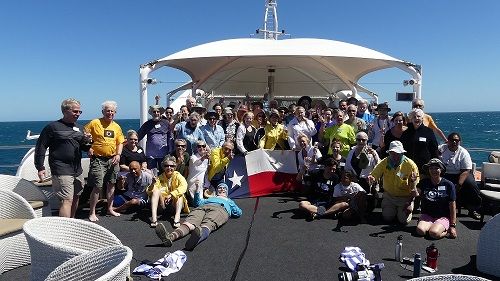Eclipse chasers avoid Texas, plan to travel south for April 8th total solar eclipse
AUSTIN (KXAN) – Professional eclipse chasers are gearing up for the April 8th, 2024 total solar eclipse. While the eclipse will pass directly over Texas, the experts won’t be here. Instead, two of the world’s best are heading to Mexico and booking ships that will take them to the Pacific Ocean.
“It’s not that Texas has bad weather, it’s just a little less likely to have good weather than Mexico,” said Fred Espenak. A scientist emeritus with NASA Goddard, Espenak has been chasing eclipses since 1970. He has witnessed 50 eclipses since then, 30 of which have been total solar eclipses.
“You’ve got to drink the Kool Aid, so to speak, to really understand what a total eclipse is all about,” Espenak said.
Paul D. Maley, Expedition Coordinator, NASA Johnson Space Center Astronomical Society, was born the day after a total solar eclipse. “I just missed that,” he said with a laugh.
Paul D. Maley has been chasing eclipses for more than 60 years. His first international trip was in 1970 to Paris. (Credit: Paul D. Maley)
Maley holds the record for eclipses recorded among the eclipse chasing elite. “If you add all the eclipses, it comes up to 82.”
What’s the deal with eclipse chasing?
Maley leads dozens of people on expeditions around the world every 18 months, when an eclipse occurs. “It’s just something that attracts people, we have individuals who once they’ve seen one, they are absolutely hooked on it,” Maley said.
Espenak describes the experience as “visceral.”
“When there’s only 1% of the Sun left, it’s still blindingly bright. You can’t look at it directly. It’s when that last 1% shrinks down and disappears in those remaining 30 seconds, it’s almost like a thunderstorm has suddenly swept over you. The light just drops right down to an eerie Twilight.”
Maley said that on one expedition in 1983, a man hyperventilated as the eclipse took place. Both describe people shouting, hollering, weeping and even lighting fireworks.
“It’s very dramatic. Chills run down your spine, the hairs on the back of your neck stand up. And deep down, you get a you get a visceral reaction, that something with nature has terribly gone amok,” Espenak said.
Hardcore eclipse chasers travel the world to witness total solar eclipses up close. This photo was taken in Svalbard, Norway in 2015. (Credit: Paul D. Maley)
Traveling the world to witnesses eclipses
Espenak said that travel is one of the main reasons he enjoys chasing. He’s been to every continent on Earth. Same for Maley.
The endeavor isn’t cheap either. For the April 8th eclipse, both men are leading expeditions to Mexico. Stays at the resort Espenak booked run around $2,500.
Maley has booked a ship to take chasers to the Pacific Ocean between Acapulco and Cabo San Lucas. Tickets aboard range from eight to fifteen thousand dollars.
A previous trip to Antarctica cost $20,000, Maley said. “We have some hardcore people that will come with us, regardless of where we go.”
Picking your spot for the eclipse
To see the number of eclipses the two have requires planning. “(You must be) looking at years of data, weather data, which you know, is never almost a guarantee, but it’s it gives you a clue.”
The two chasers are concerned for Texans’ chances next April. They say that past records show cloudy days are likely during the eclipse and chances are higher for spotting the eclipse in the south.
But don’t be disheartened if you plan on viewing the eclipse in Texas: past records aren’t perfect. That Antarctica trip Maley led saw nothing but cloudy days. Multiple ships full of people dropping $20k each missed out on the show they paid for.
Tips from the world’s best eclipse chasers
Besides watching the weather, the eclipse chases said make sure you don’t look directly at the sun until totality of the eclipse occurs.
Maley said people can have extreme reactions to total eclipses. One man on this 1983 trip to Indonesia hyperventilated after witnessing the event. (Credit: Paul D. Maley)
Maley said that most of the eclipse process occurs when the sun is still exposed. Looking at the sun without eclipse glasses at this time will damage your eyes.
Only once the sun is fully covered by the moon, when the sky becomes pitch black, is it safe to view.
The other big concern is traffic. “There’ll be people from all over the world: China, Japan, Europe… converging for the total eclipse,” Espenak said, warning that between visitors and locals, you won’t be able to get on the roads easily.
His advice is to find a place to view the eclipse ahead of time, then stay there. After the eclipse, he recommends finding a nearby restaurant, grabbing dinner and then waiting a few hours for the roads to clear.
“The words fall short to actually experiencing a total eclipse,” Espenak said. “You’ll find out.”
Source: KXAN.com


